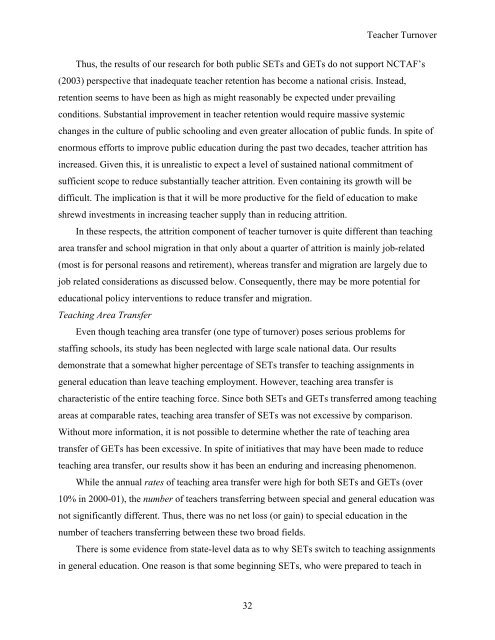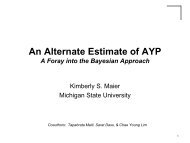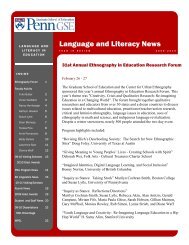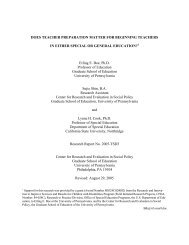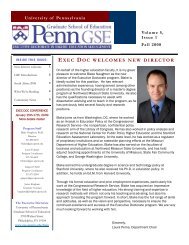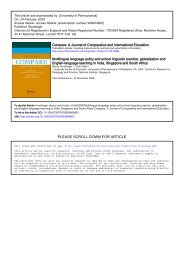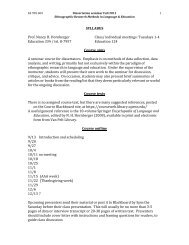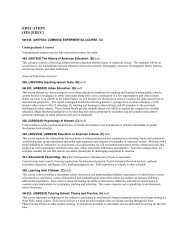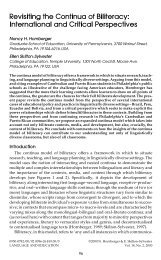Teacher turnover in special and general education: attrition
Teacher turnover in special and general education: attrition
Teacher turnover in special and general education: attrition
Create successful ePaper yourself
Turn your PDF publications into a flip-book with our unique Google optimized e-Paper software.
<strong>Teacher</strong> Turnover<br />
Thus, the results of our research for both public SETs <strong>and</strong> GETs do not support NCTAF’s<br />
(2003) perspective that <strong>in</strong>adequate teacher retention has become a national crisis. Instead,<br />
retention seems to have been as high as might reasonably be expected under prevail<strong>in</strong>g<br />
conditions. Substantial improvement <strong>in</strong> teacher retention would require massive systemic<br />
changes <strong>in</strong> the culture of public school<strong>in</strong>g <strong>and</strong> even greater allocation of public funds. In spite of<br />
enormous efforts to improve public <strong>education</strong> dur<strong>in</strong>g the past two decades, teacher <strong>attrition</strong> has<br />
<strong>in</strong>creased. Given this, it is unrealistic to expect a level of susta<strong>in</strong>ed national commitment of<br />
sufficient scope to reduce substantially teacher <strong>attrition</strong>. Even conta<strong>in</strong><strong>in</strong>g its growth will be<br />
difficult. The implication is that it will be more productive for the field of <strong>education</strong> to make<br />
shrewd <strong>in</strong>vestments <strong>in</strong> <strong>in</strong>creas<strong>in</strong>g teacher supply than <strong>in</strong> reduc<strong>in</strong>g <strong>attrition</strong>.<br />
In these respects, the <strong>attrition</strong> component of teacher <strong>turnover</strong> is quite different than teach<strong>in</strong>g<br />
area transfer <strong>and</strong> school migration <strong>in</strong> that only about a quarter of <strong>attrition</strong> is ma<strong>in</strong>ly job-related<br />
(most is for personal reasons <strong>and</strong> retirement), whereas transfer <strong>and</strong> migration are largely due to<br />
job related considerations as discussed below. Consequently, there may be more potential for<br />
<strong>education</strong>al policy <strong>in</strong>terventions to reduce transfer <strong>and</strong> migration.<br />
Teach<strong>in</strong>g Area Transfer<br />
Even though teach<strong>in</strong>g area transfer (one type of <strong>turnover</strong>) poses serious problems for<br />
staff<strong>in</strong>g schools, its study has been neglected with large scale national data. Our results<br />
demonstrate that a somewhat higher percentage of SETs transfer to teach<strong>in</strong>g assignments <strong>in</strong><br />
<strong>general</strong> <strong>education</strong> than leave teach<strong>in</strong>g employment. However, teach<strong>in</strong>g area transfer is<br />
characteristic of the entire teach<strong>in</strong>g force. S<strong>in</strong>ce both SETs <strong>and</strong> GETs transferred among teach<strong>in</strong>g<br />
areas at comparable rates, teach<strong>in</strong>g area transfer of SETs was not excessive by comparison.<br />
Without more <strong>in</strong>formation, it is not possible to determ<strong>in</strong>e whether the rate of teach<strong>in</strong>g area<br />
transfer of GETs has been excessive. In spite of <strong>in</strong>itiatives that may have been made to reduce<br />
teach<strong>in</strong>g area transfer, our results show it has been an endur<strong>in</strong>g <strong>and</strong> <strong>in</strong>creas<strong>in</strong>g phenomenon.<br />
While the annual rates of teach<strong>in</strong>g area transfer were high for both SETs <strong>and</strong> GETs (over<br />
10% <strong>in</strong> 2000-01), the number of teachers transferr<strong>in</strong>g between <strong>special</strong> <strong>and</strong> <strong>general</strong> <strong>education</strong> was<br />
not significantly different. Thus, there was no net loss (or ga<strong>in</strong>) to <strong>special</strong> <strong>education</strong> <strong>in</strong> the<br />
number of teachers transferr<strong>in</strong>g between these two broad fields.<br />
There is some evidence from state-level data as to why SETs switch to teach<strong>in</strong>g assignments<br />
<strong>in</strong> <strong>general</strong> <strong>education</strong>. One reason is that some beg<strong>in</strong>n<strong>in</strong>g SETs, who were prepared to teach <strong>in</strong><br />
32


